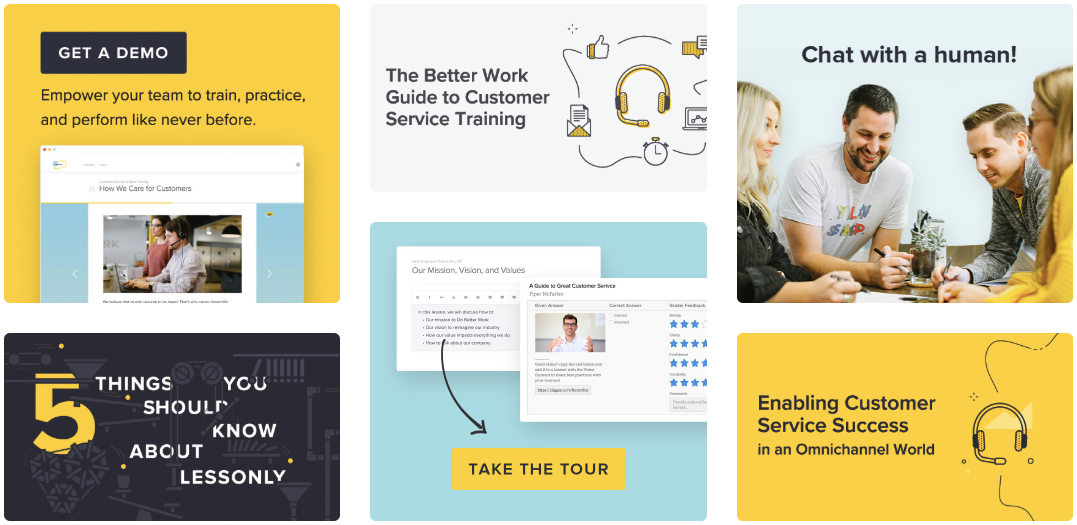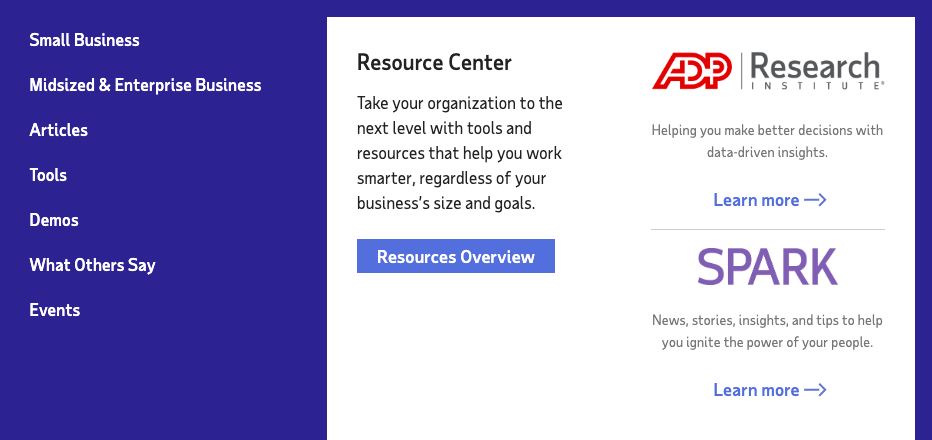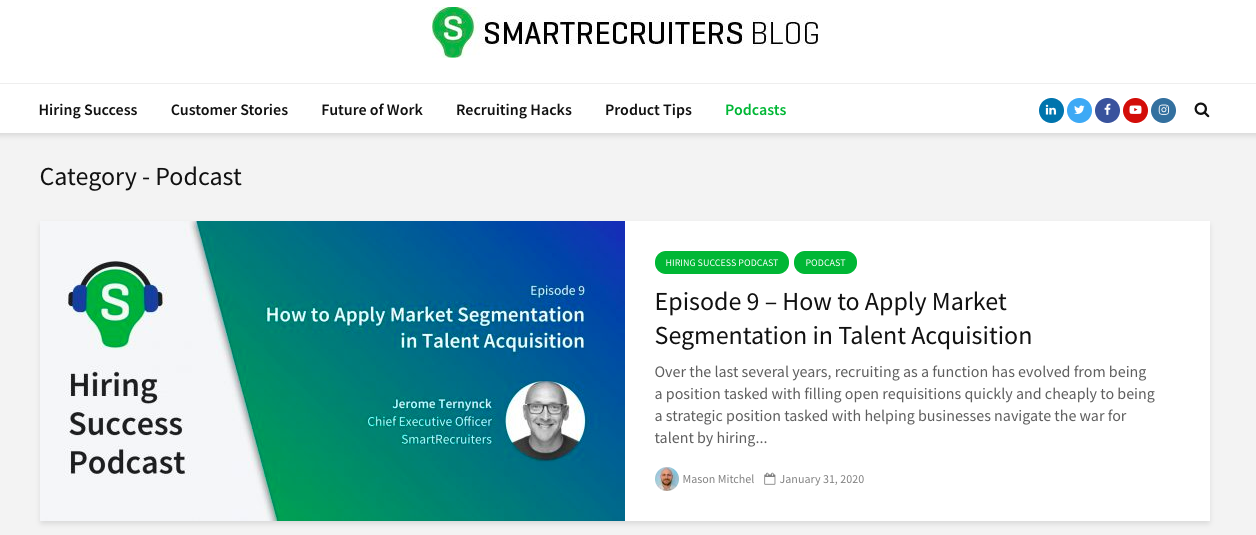
5 Tips for Content Marketing in HR Tech
5 Tips for Content Marketing in HR Tech
Alyssa Patzius, VP of Sales • Intero Digital • November 1, 2021

The human resources tech industry is a crowded one — and it’s poised to keep growing. By 2022, the HR software market is expected to exceed $10 billion. For those in the industry, this probably isn’t surprising.
Human resources touches so many areas of business that it’s a given that HR software solutions will continue to crop up to solve new pain points, provide a better user experience, and streamline HR processes.
While some companies are homing in on a specific aspect of HR, like 15Five and SmartRecruiters, others are taking a multifaceted approach and bringing numerous components together under one technology solution, like Paylocity and ADP. Regardless of the approach, content marketing can be the great equalizer for small and large companies alike. From employee branding tactics to podcasts, the HR tech industry has a variety of tools at its disposal to connect with its audience. And when content marketing is done right, it can be your competitive advantage.
Breaking Through the Crowd by Building Trust
HR professionals are bombarded with information about all the different HR solutions and technologies out there, so it can be daunting to cut through the noise to find the right solutions to fit their specific needs and budget.
To set themselves apart from the pack, HR technology vendors can use content marketing to humanize their brand by:
- Developing content that’s specifically aligned with prospects’ needs and frustrations.
- Researching keywords to pinpoint which ones they should create their content around based on what prospects are actually searching for.
- Answering their audience’s questions and sharing their experience in an educational, engaging, personalized way.
When they do this, HR tech companies can stay top of mind with prospects so that when they’re ready to buy, they turn to the company that has been educating them and building that trust.
5 Tips for Content Marketing in HR Tech
Try these tips to tap into the power of content marketing and connect with your audience:
1. Build a library of content that caters to both prospective and current customers.
A company that does this extremely well is 15Five. So let’s take a look at how they’ve employed this strategy.
Simply put, 15Five is HR software that’s narrowly focused on employee feedback. Most HR tech companies that sell more comprehensive offerings have an element that’s focused on employee feedback, so 15Five has a lot of competitors. 15Five has done a great job of recognizing its competition and developing a comprehensive content strategy that allows it to stand out.
Through its content, 15Five has established the importance of employee feedback to justify an investment in an HR tech solution that doesn’t offer services for multiple facets of human resources. The company has built an extensive library of content, including blog posts, webinars, infographics, video interviews, and e-books. This content covers a wide range of topics so that 15Five can connect with HR professionals through information that’s relevant to exactly where they are in the buyer’s journey.
Another thing HR tech companies can learn from 15Five is that a content marketing strategy doesn’t just have to focus on prospective clients — it can also continuously educate and engage current customers. When Intero Digital was a 15Five customer, we loved seeing the company promote its most recent webinar, “[DEBUNKED]: Everything You Despise About 15Five.” The promotional email promised the webinar would “tackle real feedback and empower you with best practices and simple actions you can take to boost your 15Five experience.”

This approach allows 15Five to further inform current customers and ensure its current client base is getting the most out of its service. In my role as VP of marketing, I have direct reports who submit 15Fives every week. This webinar appeals to me because I have some direct reports who love 15Five and others who are not fans of the platform, so I’m constantly looking for ways to make this resource more valuable for my team.
2. Provide a variety of types of content to engage your audience.
You’re going to have a hard time providing a truly engaging experience for your audience if you’re only publishing one or two types of content. People’s attention spans are short, so providing some variety to pique interest is paramount. Let’s look to Lessonly to get some inspiration on this front.
To borrow phrasing from its slogan, Lessonly helps people “do better work.” At its core, Lessonly believes that amazing results start with meaningful training. The company provides an easy-to-use platform that companies can use to create training materials and learning paths for employees.
Lessonly is far from the only online employee training software platform, but it differentiates itself through its clean, intuitive interface and its content marketing efforts. Right on its homepage, Lessonly offers visitors multiple types of content, including a demo, a guide to help readers provide better customer service training, five things readers should know about Lessonly, and how to offer great customer service in an omnichannel world. But Lessonly’s content marketing efforts don’t stop there.

Lessonly also hosts a conference called Yellowship, which brings together trainers and thought leaders for three days of learning. In order to attract more attendees to Yellowship, Lessonly provides a letter people can personalize to convince their boss to let them attend.
Lessonly has a robust blog that serves up helpful, actionable advice as well. Lessonly’s content doesn’t speak only to its customer base; it’s also helpful for those in HR or trainer roles, and it appeals to an even broader audience of professionals who simply want to get better at their craft. This content positions Lessonly as an authentic, helpful brand that’s not just pushing its service on its audience — it’s providing real value in a variety of formats.
3. Make it easy for your audience to find what they’re looking for.
In order for your target audience to gain value from your content, they have to be able to find it easily. A company that does a great job of this is ADP.
ADP is a big player in the HR space, offering technology that covers the areas of talent, time, benefits, and payroll management. But don’t let ADP’s size scare you — you can learn from its example regardless of how big your own company is. Content is a marketing tool that levels the playing field.
ADP’s website is extremely user-friendly, with simple features that make it a snap for visitors to find what they’re looking for. Current and prospective customers can seamlessly explore ADP’s solutions while also engaging with its educational content.
My favorite element of ADP’s content strategy is its resource center. ADP has segmented its resources based on two of its target markets: small businesses and midsized and enterprise businesses. By doing this, the company has made it simple for visitors from companies of all sizes to find content that fits their needs. The easier it is for prospects to locate valuable content on your website, the more likely it is that they will continue to engage with you rather than bounce to a competitor’s site instead.

4. Create and organize content based on personas.
Creating hyper-relevant content means approaching the content creation and distribution process with specific types of people in mind. Blackboard is a great example of this.
Blackboard is a global learning management system that partners with the education community, corporate institutions, and governmental agencies. This global focus means that Blackboard has to try to create content that appeals to visitors from a wide array of audiences.
Blackboard’s resource center is packed with content, including infographics, case studies, data sheets, and guides. The company also has a robust blog that offers up content for its audiences in the education, corporate, and governmental spaces.

On both the resource center and the blog, readers can filter content based on what market they’re interested in. And the resource center lets visitors filter even further based on role and topic, which helps prospects quickly find the right content for them. This is an example of creating content based on personas. Blackboard produces a wealth of content for a specific audience and then goes a step further and organizes it all to make sure the content is indexed and easy to find.
You can adopt a similar content strategy approach by taking advantage of content mapping. Choose a persona to target and a campaign or theme. From there, decide what long-form content, blog posts, and guest-contributed articles you’ll create that all tie back to that overarching campaign and resonate with that specific audience.
5. Go beyond the written word.
These days, people expect to be able to consume content in a variety of formats — not just written pieces. SmartRecruiters is going beyond the written word to engage its audience.
SmartRecruiters is an enterprise-grade recruiting software company that clearly understands the importance of an HR content marketing strategy.
On its homepage, SmartRecruiters promotes a guide to successful hiring and a blog post called “Scariest Parts of the Hiring Process.” Its founder and CEO published a book, and the company blog offers up content for industry professionals and current and prospective customers. There’s even a section on the SmartRecruiters site dedicated to recruitment resources, including e-books, templates, webinars, and case studies.
But SmartRecruiters knows that content marketing goes beyond written copy. The company also releases podcasts; the most recent is called the “Hiring Success Podcast.” It has featured a variety of hosts, including the CEO of SmartRecruiters, the global talent attraction director of Visa, and a recruiting senior analyst from Optimizely.

SmartRecruiters is a prime example of an HR tech company that creates a variety of content types on a variety of topics that are relevant to its audience at a variety of stages of the buyer’s journey. This way, the company can reach its audience members with informative, helpful, engaging content no matter where they are on their path to purchase.
Marketing HR tech can be tricky given how saturated the market is these days. Developing a content marketing strategy can help human resources technology companies reach their audience in a way that truly resonates and builds trust.
